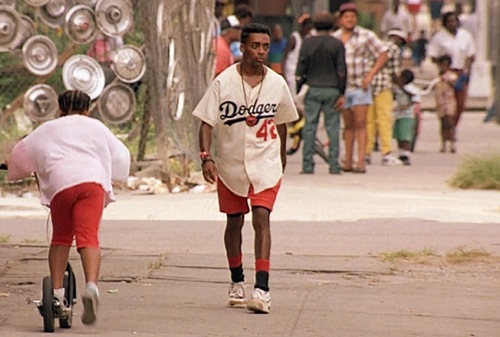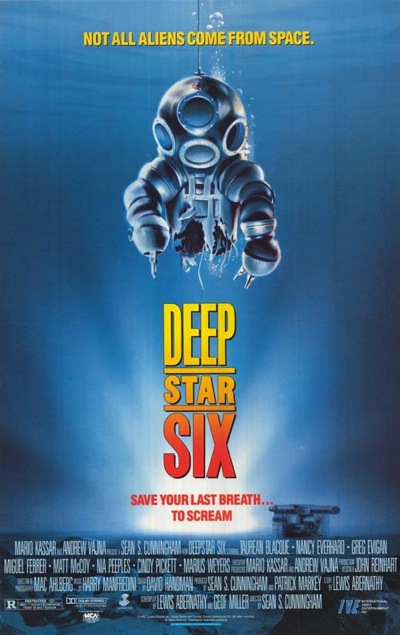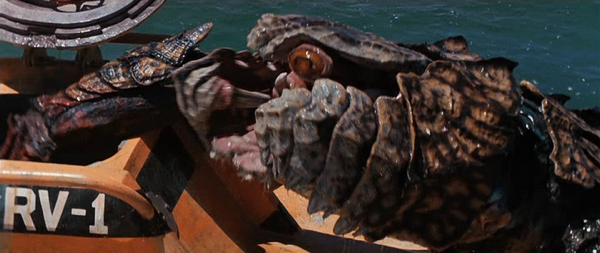
Twenty-five years ago, the American film industry experienced a series of seismic shifts that altered our notions of what was possible both creatively and financially within the medium. 1989 was a year of record grosses, indie film crossovers, the first substantial tightening of the theatrical release window, and the rise of the Gen X auteur. It was the year of BATMAN, DO THE RIGHT THING, HEATHERS and SEX, LIES AND VIDEOTAPE. It was also, less significantly, the year I turned sixteen.
Some of these filmmaking transformations were predictable, while others were accidents caused by young directors resisting the studio yoke and telling stories their own way - and I don't know if these changes would've registered as strongly with me had I been living in one of the major markets. Being consigned to Bowling Green, Ohio gave me a frustrated outsider's perspective. I had access to the all of the noteworthy film publications and weekly trades, but only saw a fraction of these movies during their theatrical release; exhibitors thought they knew what Middle America wanted to see, and tried to keep the unruly/odd/prurient independent stuff out of our multiplexes. This made me resent the formulaic crap that continually hogged my small town's six movie screens. Just as I'd gravitated toward alternative music once I hit junior high, I was now hungry for deeply fucked-up movies by directors who weren't appropriating the feel-good Amblin aesthetic or the John Hughes faux-teen-catharsis-with-an-MTV-friendly-soundtrack nonsense - and I wanted that shit now. Screw waiting a year for Alex Cox's latest to hit video, by which point I'd have to dig through back issues of film magazines to catch up with the reviews (only to find that the critics were just as puzzled by WALKER as I was). I wanted to be engaged in the critical fray while the blood was being spilled!
1989 was the year the indie uprising spilled out of New York City and Los Angeles, and it was "game on" for anyone with a bit of moxie and access to a Bolex camera. Guys like Spike Lee, Steven Soderbergh, Jim Jarmusch and the HEATHERS team of Michael Lehmann and Daniel Waters didn't make it look easy, but they did give cinephiles the sense that something personal and, perhaps, revolutionary was possible. Quentin Tarantino was paying attention. So were Richard Linklater and Kevin Smith. Within two years, the cinematic landscape would look entirely different, and the studios would be scrambling to co-opt this strange new filmic counterculture.
And then there was Tim Burton's BATMAN, which ushered in the era of the front-loaded blockbuster and the still-thriving template of the dark-and-brooding superhero movie (the latter largely derived from Frank Miller's groundbreaking THE DARK KNIGHT RETURNS comic book series). BATMAN led an insanely profitable summer that featured far more creative disappointments than triumphs - and the few creative triumphs were major commercial disappointments. One of the most fascinating what-ifs in film history revolves around the financial failure of James Cameron's THE ABYSS: had it been a hit, would Cameron have gone on to make another original movie instead of TERMINATOR 2? And what if Columbia Pictures had held Brian De Palma's CASUALTIES OF WAR until the fall, giving the film the awards push it deserved instead of unloading the searingly tragic Vietnam drama in the middle of August?
To celebrate the twenty-fifth anniversary of this hugely influential year in film, I've decided to revisit my 1989 moviegoing choices weekend-by-weekend. I realize I'm starting couple of weeks late, but cut me some slack: I just came up with the idea, and the first weekend of January 1989 was devoid of new releases. I'm going to start with the second weekend of January, post a catch-up piece this week (if only to break things up for the tl;dr crowd), and keep things going at an article-a-week clip throughout the year. I'll also be reaching out to the filmmakers who contributed to this watershed period in cinema for interviews either in print or podcast form. I've already got a couple of tremendous directors lined up for later in the year, and I'm hoping to round up many more.
But let's begin with the first theatrical release I saw in 1989. It was a real good one.

January 13, 2013
The Movie: DEEPSTAR SIX (d. Sean Cunningham, w. Lewis Abernathy and Geof Miller, from a story by Abernathy)
The Competition: THE JANUARY MAN, GLEAMING THE CUBE, nationwide expansion of BEACHES.
The Rationale: I couldn't sell my friends on "the new movie from the guy who wrote MOONSTRUCK", the skateboarding fad was on the wane in Bowling Green and, seriously, fuck BEACHES.
Hollywood had just closed the books on a yeal-long run of age-swap movies (LIKE FATHER, LIKE SON; VICE VERSA; 18 AGAIN and BIG) when it inexplicably caught the blue-collar-workers-get-attacked-by-a-sea-creature-while-stationed-in-an-underwater-outpost-on-the-ocean-floor bug. Unlike the age-swap phenomenon, this phase was oddly specific and almost certainly the result of rival studios/production companies reacting to James Cameron's THE ABYSS (which began heading toward production in early 1988). Why these execs and producers determined this was a profitable trend they had to leap out in front of is still baffling. There's not a lot going on a mile beneath the ocean's surface; it's dark, dull and deadly due to extreme pressure. Essentially, you're making an outer-space movie with airlocks replaced by decompression chambers. No one thought this through.
At the time, I was hooked by the vague possibility of giant sea monsters emerging from the unexplored depths to terrorize commercial fishermen and cruise ship passengers - a terrifying, mayhem-laden hybrid of JAWS and kaiju movies. Unfortunately, the filmmakers weren't thinking quite this big; they had their noses buried deep in the ALIEN playbook, and they were following it step-by-step.
While I had moderate hope for George Pan Cosmatos's LEVIATHAN (due out that March), I knew full well what to expect from a January release directed by Sean S. Cunningham: a quick-and-cheap horror flick with enough gore-soaked set pieces to fill out a glossy FANGORIA spread. Though it generally delivers in the gore department, the movie isn't exactly quick or cheap. Executive produced by the spendthrift Carolco team of Mario Kassar and Andrew G. Vajna (friends to the musclebound movie star), DEEPSTAR SIX lumbers through some interminably dense exposition - the U.S. Navy has commissioned a crew of officers and scientists to build a nuclear missile base in a historically-treacherous underwater cavern - before getting its haphazardly-designed monster up and munching. And while the sets aren't exactly worthy of William Cameron Menzies, they're bigger than what you'd get on a Roger Corman picture and frequently flooded with water (which is just begging to go over-budget).
If it looks like Kassar and Vajna spent more money than they should've here, they hedged their bets by casting wildly affordable character actors. Greg Evigan of BJ AND THE BEAR (and papa of our beloved Briana Evigan) stars opposite Nancy Everheard, who is probably most recognizable for... her performance in DEEPSTAR SIX? The supporting cast includes HILL STREET BLUES' Taurean Blackque (who actually gets top billing over Evigan), Nia Peeples, Matt McCoy (Steve Guttenberg's replacement in the POLICE ACADEMY franchise), Cindy Pickett (Ferris Bueller's mother), Thom "Murray Bozinski" Bray and the once and future Miguel Ferrer. The star here, I guess, was the concept, which likely explains why DEEPSTAR SIX opened eighth at the box office that weekend.
The problem with DEEPSTAR SIX, and basically all of the films in this wacky subgenre, is that they're monster movies with really shitty monsters. People weren't lining up to see a movie set on the ocean floor because they were excited by the potential of one day living there themselves (as is the partial draw with planetary colonization tales); they just wanted to see a big, scary-looking sea creature snack on D-list actors for ninety minutes. Unfortunately, DEEPSTAR SIX made no attempt to sell its monster, and for good reason. When the brilliant Greg Nicotero shows off his portfolio of amazing creature designs, I doubt he starts here:

The way-too-late reveal of Monsieur Lobster is a classic we-never-got-the-design-right admission of defeat by the f/x team. Early in the film, Nia Peeples's big-brained oceanographer teases the possibility of sea monsters up to ten meters in length, which sounds awesome; then we get this guy, who'd get his clock cleaned by Pumpkinhead. We don't see the creature in full more than a few times (mostly because it looks like he's constantly falling apart), but there is a great close-up during a laboratory attack when a phone cord gets tangled around one of his fangs. Even if M. Lobster is a total botch, it's cool seeing a practically-built creature of that scale rampaging in a non-CG environment.
DEEPSTAR SIX's sole saving grace is Ferrer, who plays a twitchy facility technician who desperately wants to get topside. Ferrer had already established himself as one of filmdom's great irritants with ROBOCOP, and he's having a good time here as a sadsack who keeps fucking up on a catastrophic level. Ferrer also figures prominently in the film's two best f/x gags: one where he accidentally explodes the chest of the outpost's architect with a shark dart, the other where he takes off in an escape pod without decompressing. A year later, we'd fall in love with Ferrer all over again as Sheriff Harry S. Truman's bête noire Albert Rosenfield in TWIN PEAKS.
Rewatching DEEPSTAR SIX was, if nothing else, an aesthetically nostalgic experience in that the only version available is a shitty transfer of the 1989 Live Entertainment VHS release. When it comes to lousy '80s horror movies, I think this is often the ideal presentation (e.g. there's something terribly off-puitting about watching a beautifully restored version of Joe Zito's THE PROWLER). But unlike the early-to-mid-'80s slashers, I don't have much in the way of nostalgia for DEEPSTAR SIX; this was a past-its-expiration-date retread of ALIEN lazily trying to glom onto yet another trend that wasn't quite a trend yet (and never would be). It was Hollywood at its unimaginative worst, all overseen by an awful director, Cunningham, who'd made his name on a HALLOWEEN knockoff. (According to the ever-unreliable IMDb, THE HITCHER's Robert Harmon was once in the running to direct DEEPSTAR SIX. At least he knew how to craft an above-average B-movie.)
But this is the deal we've made as horror fans: we watch everything because we know that dumpster diving occasionally pays off. I knew that in 1989, and I hold to it now. So while I felt burned walking out of DEEPSTAR SIX, it didn't infuriate me to the degree that Ivan Reitman's abominable TWINS had a few weeks earlier. That film represented the nadir of high-concept pandering; it was a fundamentally evil swindle that wasted its best joke on a controversial Premiere Magazine cover. Films like TWINS were the enemy. They still are. DEEPSTAR SIX was a quickly forgotten piece of trash that I've now wasted 1,000 words on, and I promise this series will get more interesting.
Next up: A couple of 1988 prestige films arrive in B.G.: RAIN MAN and MISSISSIPPI BURNING.
Faithfully submitted,
Jeremy Smith
